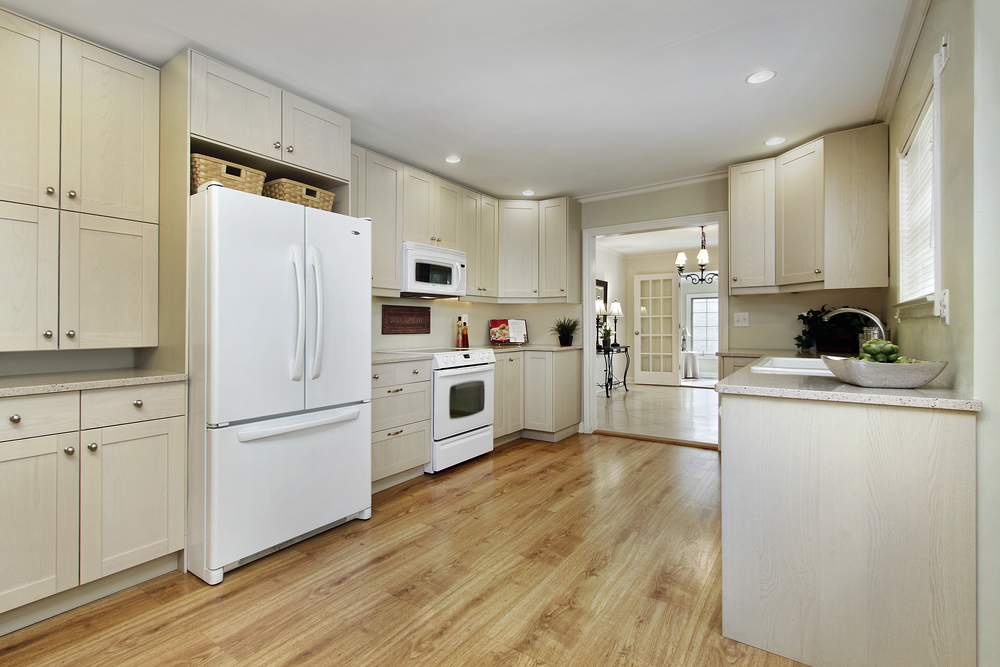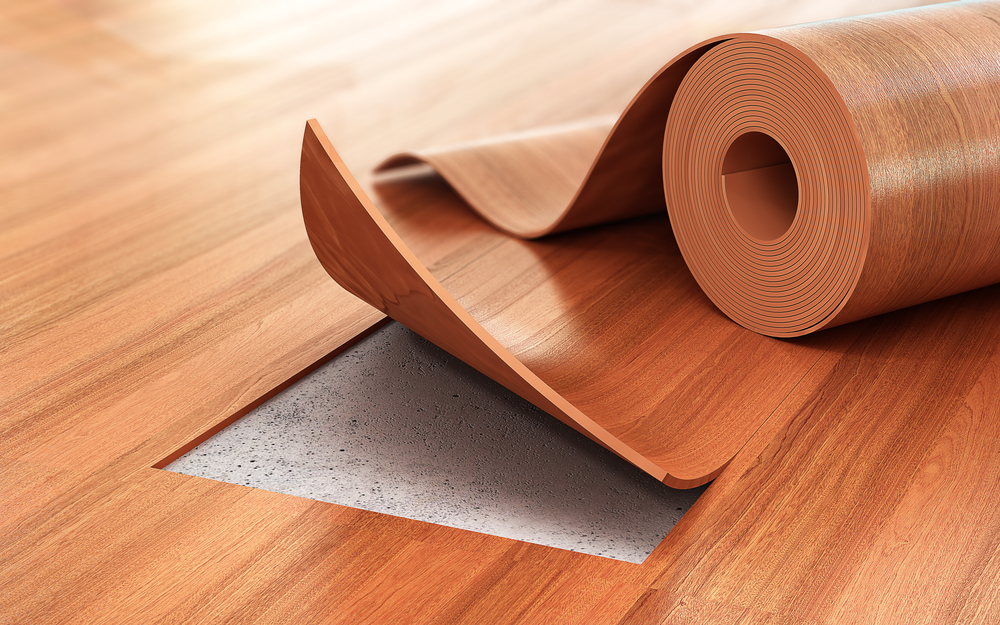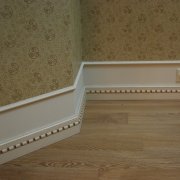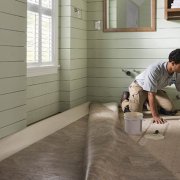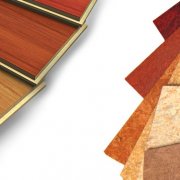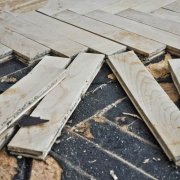Linoleum for the kitchen
Linoleum invariably leads the market for flooring due to its practicality and relatively low price. In the kitchen, which usually has to be repaired every 10 years, or even more often, you always want to lay the most wear-resistant coating. But attractive design should not be forgotten. The place where the hostess cooks, where the family gathers at the table every day, where they receive guests, should be pleasing to the eye. Therefore, it is important to lay a beautiful linoleum in the kitchen.
There is an opinion that the floor in the kitchen under linoleum is difficult to prepare, and that such a coating in the interior will not look harmonious. The question often arises: what is better to lay - linoleum, tile or laminate? But inventive manufacturers began to offer such high-tech types of linoleum for the kitchen that there are no difficulties with laying and it could even decorate the living room. In this article we will try to give useful tips on which linoleum to choose for the kitchen.
The content of the article
Requirements for linoleum for the kitchen
Should linoleum for the kitchen be any special, or can it be the same in the whole apartment? Let’s figure out what the requirements for decoration specialists and, of course, the owners themselves to linoleum for the kitchen.
- In view of the frequency of attendance at this home “meeting place that cannot be changed,” kitchen linoleum must be durable - the coating has to withstand thousands of steps, hundreds of objects falling on it, including sharp cutlery, and, finally, dozens of raids by children whose experiments may not benefit linoleum.
- The selected coating should not absorb moisture (experts call this property low hygroscopicity), because in addition to increased humidity in the room, it is also subjected to wet cleaning more often than in other rooms - you can not get rid of endless crumbs, splashes and stains without washing. For the same reason, it is advisable to choose linoleum for the kitchen as wide as possible - this way laying is achieved with the least number of joints where moisture gets.
- It is useful for the health and safety of family members to consider when choosing which linoleum to lay in the kitchen, whether it will prevent slipping and exhibit antibacterial properties - I do not want to get injured or catch an infection due to the poorly selected coating.
Varieties of linoleum
To choose the best linoleum for the kitchen, it is important to know what linoleum is in general. It is customary to classify the coating by material (natural and artificial) and by scope of application (household, semi-commercial, commercial and special).
Natural linoleum
Consider what its features are and whether it is suitable for the kitchen. Natural linoleum has many positive characteristics, among them durability and an enviable service life (some manufacturers promise wear resistance and color retention up to 45 years), antibacterial and antistatic properties. The choice of linoleum in the kitchen rarely dwells on such an elite coating, more common in the decoration of living rooms.
Why is the cost so high? The components are quite expensive: cork or wood flour, which gives smoothness and protects the color of the coating, linseed oil, wood resin, due to which linoleum becomes strong and elastic, coloring pigments from natural materials and hygienic jute fiber from which the substrate is made.
Artificial, or synthetic, linoleum
Artificial linoleum has some advantages over natural: it is much cheaper and easier to lay. High-quality and beautiful linoleum for the kitchen is not always the most expensive.The basis for artificial linoleum, traditionally used in residential buildings, is PVC (polyvinyl chloride). If applied in one layer - this is a homogeneous coating, if in several - this linoleum is called heterogeneous (multilayer).
Homogeneous is characterized by subtlety, lightness due to the lack of a base, however, it is durable and reliable. When choosing such a linoleum for the kitchen, please note that even if you apply protective equipment and follow the rules of care, it will not last more than 10 years. Heterogeneous consists of several layers, their number determines the quality of the coating. In the standard version, there is a substrate, fiberglass, a layer with a design, a protective top layer. Its thickness also affects the quality, and therefore the price of linoleum. Sometimes additional protective layers are added.
It is not easy to decide which type of linoleum for the kitchen to give preference to. Both natural and artificial linoleum correspond to the requirements stated for coverage, provided that the manufacturer is in good faith. Both types are characterized by ease of use, resistance to mechanical damage, moisture and heat resistance.
We advise you to make decisions based on circumstances. If the budget is limited, and the task is to save both on coverage and laying - choose artificial (it is cheaper and because of the ease of laying it can be done independently). If you want linoleum in the interior of the kitchen to become the central decoration, and the purchase of a higher cover with payment for laying services is not a problem, then why not choose linoleum for the kitchen from natural raw materials.
Classification by field of application
It was previously mentioned that in addition to the division into natural and artificial, linoleum in everyday use is also classified into household, semi-commercial, commercial and special. In the conversation of professionals, it will most likely be about the class of coverage, which will be described by a two-digit number. Moreover, the first digit will indicate the area of application of linoleum (2 - residential, 3 - office, retail or social premises, 4 - industrial); and the second is the level of withstand mechanical and abrasive loads (from 1 to 4).
41 and above - too much for an apartment, in particular for a kitchen (even for an office, here we are already talking about extreme loads). 21 and 22 are too few, and the first falling fork will cause irreparable damage. What class of linoleum for the kitchen to choose? A suitable option is either household linoleum with significant resistance to stress (23 and 24), or semi-commercial not the highest resistance (31 and 32). In this case, the price-quality ratio will be fair.
Material Release Form
Accustomed to seeing large linoleum rolls in construction stores with a width ranging from one and a half to 5 meters.? Even those relatively small rolls into which the purchased part is rolled up are difficult to take home and bring there, and it is not easy to mount such a cover without assistance. Few people know that linoleum is produced in other forms: for example, narrow panels that look like laminate or square tiles. Even a novice master can mount such small details, or you yourself will try yourself in this role. And if, despite the careful choice of linoleum for the kitchen, a part suffers during operation, replacing only this part is quick and cheap.
Nevertheless, it is recommended to lay a traditional roll linoleum in the kitchen (and the wider the better) so as not to get the many joints that are inevitable when laying a tile or imitating linoleum panel. Dirt and moisture, clogging in the joints, will force to repair the kitchen again earlier than planned.
How not to make a mistake with the quality of linoleum for the kitchen?
The sure way to make no mistake is to pay attention at the purchase stage.To choose high-quality linoleum for the kitchen, hallway or corridor (and other home rooms), do not hesitate to carefully examine the selected sample and the available documents. Pay attention to the pattern - how clearly and symmetrically it is applied, whether the step of the picture is less than a meter and a half. On the surface - whether or not there is an unnatural brilliance. And finally, the presence of the manufacturer’s logo on the back of the coating. Also, when choosing linoleum, beware of a sharp unpleasant odor.
The seller is obliged at the request of the buyer to provide a certificate of conformity for review. And in the documents accompanying the batch, check the complete information about the manufacturer - the name and contacts for handling the claim if a marriage is found.
If you plan to pre-visit the online store, photos and reviews from other customers will help you.
Drawing and shades of linoleum coating for the kitchen
The beautiful linoleum for the kitchen in the classic version appears in one of the shades of brown (from beige to chocolate, depending on which tree imitates the coating). But modern design solutions do not focus on imitating elite species of wood, or even stone or tile. Replace the ageless classics, country, and provence in the design of the kitchen come hi-tech and modern with bright and rich colors. And pop art and an eclectic interior can easily be beaten with abstract or geometric patterns on linoleum. Fortunately, manufacturers today offer so many color and structural solutions that the imagination of the owner choosing linoleum for the kitchen is limited only by budget. We recommend only to remember: in order not to suffer from the question of how to wash linoleum in the kitchen, you should not choose a too light option.
Briefly - about laying linoleum
The first question that arises when deciding on laying is not how to lay linoleum in the kitchen, but how to properly prepare the floor. The main thing is to level and clean the surface. If it is concrete, carefully identify and repair cracks and gaps with concrete-adhesive mixtures. If this is an old linoleum - check for damage and bumps. If sheets of plywood - the seams between them are closed with putty on wood. The final stage of preparation is to vacuum the surface, especially before laying thin linoleum, under which every unevenness is striking and creates a zone of increased rubbing of the coating.
Lay linoleum with glue (linoleum without a base) or using silicone or the method of "cold welding" of joints (for example, if a layer of thermal insulation is placed under the linoleum). Regardless of the method chosen, the master finisher will say that the coating must first be laid down. Linoleum is laid out and wait at least 24 hours until it is completely smoothed out before installation. Then they cut off according to the shape of the room, taking into account the protrusions and not forgetting to leave a gap near the walls (from 0.8 to 1 cm). After that proceed to installation.
We hope that our tips on choosing linoleum for your kitchen will be useful to you. Repair with pleasure!

